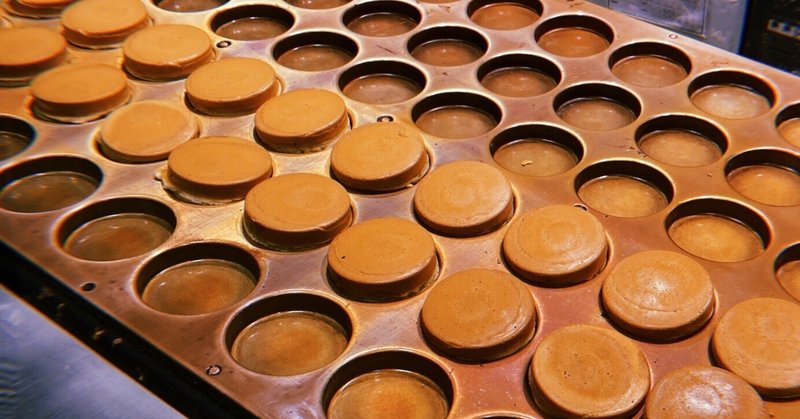
Dig Japan vol.4 “Imagawa-yaki (今川焼き)”
Imagawa-yaki (今川焼き) is disc-shaped wagashi made by filling dough with azuki bean paste, custard cream, or other fillings and baking it in a mold. Its name is not standardized, and it is called by various names including “Oban-yaki (大判焼き),” depending on the region and store. Imagawa-yaki is familiar to Japanese people, as it is often sold not only at confectionery stores, but also at open-air stalls at so-called festivals, including Shinto and Buddhist ceremonies.

The general imagawa-yaki recipe is to pour the batter into a circular concave mold made of iron or copper, fill it with bean paste, and then bake it into a thick disk. The first time it appeared in historical documents is “Imagawa-yaki Nasuya Yahei Honjo (今川やき 那須屋弥平 本所)” which appeared in the Edo specialty sweets section of “Fukijizai (富貴地座位)” written in 1777. However, it is unknown what kind of confectionery it was at that time.
Imagawa-yaki in its current form can be seen in Harukaze Shimizu (清水晴風)'s “Machi no Sugata (街の姿)” which depicts the customs at the end of the Edo period. According to it, imagawa-yaki was baked on a small iron plate with six cavities and was sold at food stalls for 4 mon (文: Japanese currency at the time) for two pieces. In those days, a child's pocket money was about 4 mon, so its business could be said for children.

During the Meiji period, it was very popular as a snack for folks and was widely sold. Taichiro Morinaga, the founder of Morinaga & Co., went so far as to say, “As long as there are baked sweet potato shops and imagawa-yaki, it would be difficult for Western confectionery to expand to Ginza.”
Although there are no reliable historical sources on the origin of the name imagawa-yaki, it is said that the most popular one today is a shop near the Imagawa Bridge, which was built by Zen'emon Imagawa, a feudal lord in Edo city, during the Yasunaga era in the middle of the Edo period. And there is a theory that the store advertised and sold it as imagawa-yaki, a reference to the Okehazama War, and it won popularity, so it became a common noun and spread. However, this name is not unified nationwide, and is called differently depending on the region and each store.

A typical name other than imagawa-yaki is “Oban-yaki (大判焼き)” which is popular in Tohoku, Tokai, and Shikoku. It is said that its origin dates back to around 1955, when a confectionery equipment manufacturer in Ehime Prefecture began selling imagawa-yaki, which was one size larger than the conventional one, under the name Oban-yaki. Imagawa-yaki is also called “Kaiten-yaki (回転焼き)” or “Kaiten-manju (回転まんじゅう)” because of its unique producing method, which involves rotating a circular baking pan with a shaft in the center. This is a familiar name in Kansai and Kyushu. There are countless other ways to call imagawa-yaki, such as “Nijyu-yaki (二重焼き)” in Hiroshima, “Taiko-yaki (太鼓焼き)” in Wakayama, and “Oyaki (おやき)” in Hokkaido.
Basically, imagawa-yaki is filled with azuki bean paste (tsubuan or koshian), but some filled with white bean paste, custard cream, chocolate cream, matcha cream, strawberry jam, cream cheese, and caramel sauce and so on. There is also one like a side dish, contained hamburger steak or sausage.
This article was written by 𝐡𝐢𝐫𝐨𝐤𝐨, working as a freelance translator and press for overseas apparel brands in Japan, with the purpose of broadening her insight into the Japanese traditional culture.
いつも読んでくださってありがとうございます☺︎いただいたサポートは、記事のクオリティ向上に活用させていただきます。応援よろしくお願いします❦
